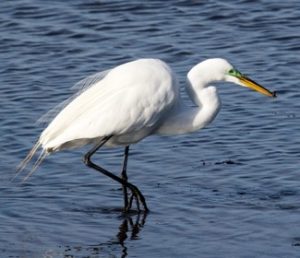Great Blue Heron
Ardea herodias

Image by Michael L. Baird from Wikimedia, CC BY 2.0
Physical: Great Blue Herons reach up to 132 cm in length. Their head is white with a black stripe on each side. They extend back to small plumes. Dorsally, they are grayish-blue with a white breast.
Habitat: A. herodias live in lakes, ponds, rivers, and marshes. They range from Nova Scotia south to Florida, and west along the Gulf Coast to Texas.
Feeding: Herons feed mainly on small fish, but will eat shellfish, insects, rodents, frogs, and reptiles. They hunt by standing motionless in the water until the spot and strike at their prey.
Breeding: A. herodias lay from 3-7 eggs that are pale green-blue. The nest is a shallow platform of sticks lined with down. Nests are elevated, but can be on the ground. Breeding grounds cover local water bodies south of the northern U.S. border.
JUVENILE
Physical: Juveniles are generally browner in coloration than adults. They have a black cap and brownish-gray upper wings. Juveniles lack the shaggy neck and plumes of the adults.
Habitat: A. herodias live in lakes, ponds, rivers, and marshes. They range from Nova Scotia south to Florida, and west along the Gulf Coast to Texas.
Feeding: Herons feed mainly on small fish, but will eat shellfish, insects, rodents, frogs, and reptiles. They hunt by standing motionless in the water until the spot and strike at their prey.
Breeding: A. herodias lay from 3-7 eggs that are pale green-blue. The nest is a shallow platform of sticks lined with down. Nests are elevated, but can be on the ground. Breeding grounds cover local water bodies south of the northern U.S. border.

Sign up for email or connect through social media.